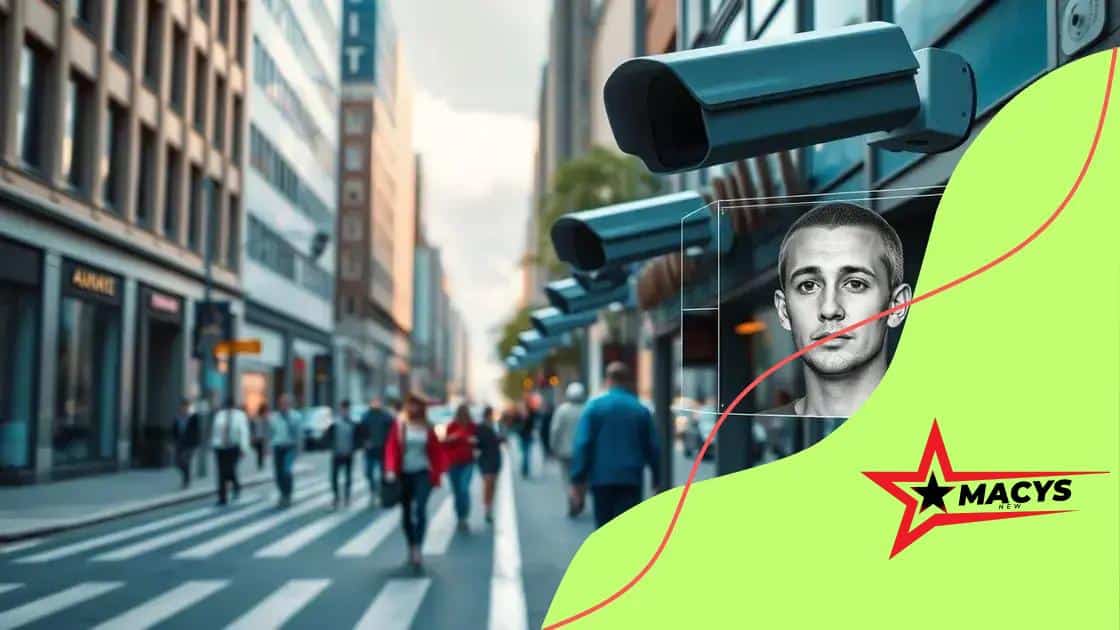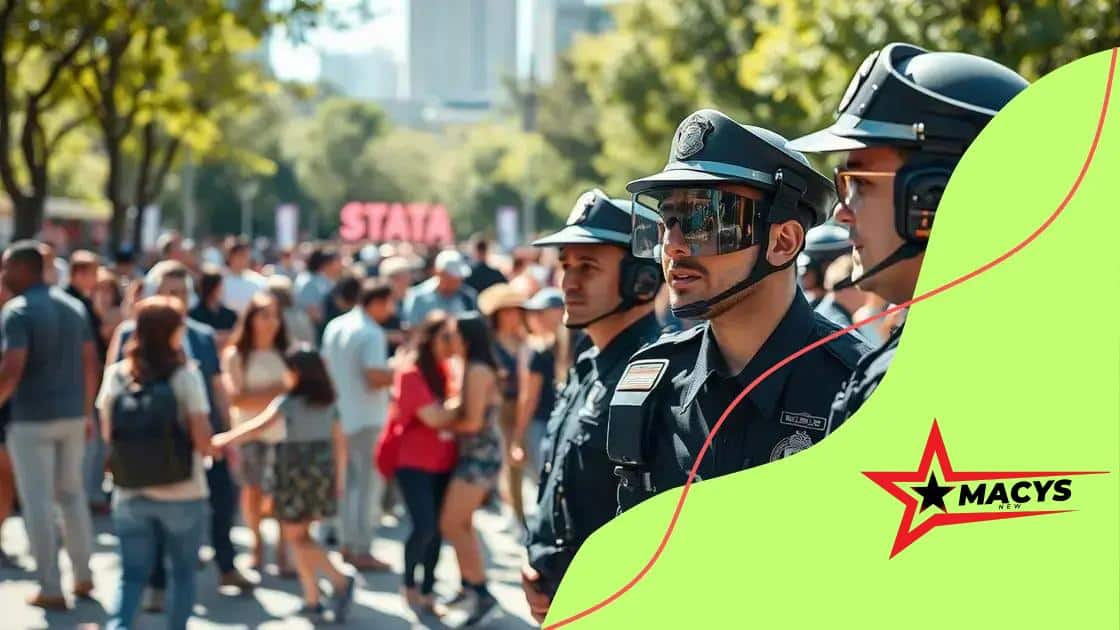The role of facial recognition in enhancing public safety

The role of facial recognition in enhancing public safety includes improving law enforcement response times, deterring crime, and enabling real-time monitoring, while also raising critical privacy and ethical concerns.
The role of facial recognition in enhancing public safety is a topic that sparks debates and curiosity. With its growing use in various settings, how does it shape our everyday lives? Let’s dive into this pressing issue.
Understanding facial recognition technology
Facial recognition technology is becoming a key element in our daily lives. It helps in identifying individuals by analyzing facial features. This technology has evolved, making it faster and more accurate.
How it Works
Facial recognition uses a complex algorithm to match a person’s face against a database. It involves several steps:
- Detection: The system locates a face in an image or video.
- Analysis: Key facial features are measured and encoded.
- Matching: The encoded data is compared to existing records.
This process takes just seconds, allowing for quick identification.
Applications in Daily Life
Facial recognition is used in various everyday situations. Here are some common applications:
- Smartphones: Many devices unlock using your face.
- Security: Airports and buildings use it to enhance safety.
- Social Media: Platforms tag friends automatically in photos.
The technology provides convenience, but it also raises important questions about privacy.
As we continue to integrate facial recognition into our systems, it’s essential to consider its impact on society. Understanding how it works can help us make informed decisions about its use. We must balance the benefits with the necessary precautions to protect our privacy.
Applications in law enforcement
Facial recognition technology plays a vital role in law enforcement today. It helps officers quickly identify suspects and enhance public safety.
Real-Time Crime Fighting
In many cities, police use facial recognition systems during live events and crowded situations. This allows them to:
- Detect individuals: Officers can spot wanted criminals in real-time.
- Enhance investigations: Analyzing footage helps piece together events.
- Prevent crime: The presence of surveillance can deter criminal acts.
By integrating this technology into their operations, law enforcement agencies improve response times and outcomes.
Case Studies
There are several instances where facial recognition technology made a significant impact. For example:
- Events Security: During large gatherings, such as concerts, police can identify known offenders.
- Missing Persons: Facial recognition is essential in locating missing individuals by matching against databases.
These applications show the versatility and effectiveness of this technology in protecting communities.
Despite its benefits, the use of facial recognition in law enforcement raises important discussions about privacy and ethics. It’s crucial for agencies to implement clear policies to maintain public trust. Ensuring transparent use can foster a balance between safety and individual rights.
Benefits to community safety

Facial recognition technology offers numerous benefits to community safety. By enhancing security measures, it plays a vital role in making neighborhoods safer.
Deterrence of Criminal Activity
The presence of facial recognition systems can deter potential criminals. When people know they are being monitored, they may think twice before committing a crime. This proactive approach can significantly reduce incidences of violence, theft, and vandalism in public spaces.
Improved Emergency Response
Facial recognition aids in quick identification of suspects during emergencies. This allows law enforcement to:
- Act quickly: Fast identification leads to quicker responses.
- Increase safety: Knowing a suspect’s background helps officers make informed decisions.
- Coordinate with other agencies: Sharing information across departments enhances overall safety.
By having access to accurate data, police can better protect communities.
Enhanced Surveillance
Facial recognition systems improve surveillance capabilities. They can monitor large events and crowded areas effectively. Utilizing this technology facilitates:
- Real-time monitoring: Authorities can act immediately on suspicious activities.
- Incident analysis: Recorded footage provides valuable evidence for investigations.
This leads to a faster resolution of crimes and increased confidence in public safety.
Overall, the integration of facial recognition technology empowers communities by enhancing safety and trust between citizens and law enforcement. The effective use of these systems can help create environments where people feel secure to live and thrive.
Privacy concerns and ethical implications
While facial recognition technology brings many advantages, it also raises significant privacy concerns and ethical implications. Understanding these issues is crucial for balancing safety with personal rights.
Invasion of Privacy
Facial recognition systems can operate without individuals’ knowledge. This capability makes it easy for governments and companies to track people’s movements. Many worry that this constant surveillance threatens personal freedom.
Data Security Risks
The data collected through facial recognition is sensitive. If not properly secured, such information can be vulnerable to breaches. Here are key risks:
- Unauthorized access: Hackers might steal personal data.
- Misuse of information: Data can be used for wrongful purposes.
- Lack of consent: Many people do not agree to their images being stored.
These factors create an urgent need for regulations to protect personal information.
Bias and Discrimination
Another concern involves the potential for bias in facial recognition technology. Studies indicate that these systems may misidentify individuals from certain racial and ethnic groups more often than others. This can lead to:
- False accusations: An innocent person might be wrongly identified as a suspect.
- Systemic discrimination: Disparities can further marginalize already vulnerable communities.
Addressing these biases is essential in developing fair and effective systems.
As facial recognition technology continues to evolve, society must grapple with these challenges. Engaging in open discussions about ethics and privacy will help to guide the future of this powerful technology.
Future trends in facial recognition
Facial recognition technology is constantly evolving, and understanding the future trends in facial recognition can help us prepare for what’s next. As innovations emerge, various sectors will adopt these advancements to improve security and efficiency.
Integration with AI and Machine Learning
The future of facial recognition lies in its integration with advanced artificial intelligence (AI) and machine learning. These technologies will enhance accuracy and reduce errors. Here’s how:
- Better accuracy: AI can learn from vast amounts of data to improve identification rates.
- Adaptive systems: Machine learning allows systems to adapt to new environments and diverse populations.
- Real-time processing: Combining AI will lead to faster recognition speeds, crucial for safety measures.
As these improvements take shape, we can expect more reliable systems in public spaces.
Regulatory Developments
As facial recognition becomes more widespread, many governments will likely create new regulations. These regulations will focus on privacy and ethical use. Important aspects might include:
- Transparency: Companies must inform users when their data is being collected.
- Data protection: Strong measures will be needed to secure sensitive information.
- Public oversight: Third-party audits may become standard to ensure compliance with laws.
Such regulations can help restore trust in technological progress.
Wider Adoption Across Industries
We will see facial recognition becoming more common across diverse fields. From retail to healthcare, businesses will harness this technology to enhance services. This might involve:
- Personalized shopping: Retail stores can tailor experiences to customers based on their profiles.
- Streamlined healthcare: Hospitals can identify patients and manage records more efficiently.
The increasing demand for security and efficiency will drive the use of facial recognition systems.
Overall, the future of facial recognition appears promising, with advancements expected to improve society. We must navigate this landscape smartly, balancing innovation with ethical considerations.
FAQ – Frequently Asked Questions about Facial Recognition Technology
How does facial recognition technology improve public safety?
Facial recognition technology enhances public safety by helping law enforcement quickly identify suspects and monitor crowded places.
What are the main privacy concerns associated with facial recognition?
The primary privacy concerns involve unauthorized tracking, data breaches, and individual consent for data collection.
How can we address bias in facial recognition systems?
Addressing bias requires improving training data diversity, implementing better algorithms, and regularly auditing the systems for fairness.
What future trends can we expect in facial recognition technology?
Future trends include integration with AI for improved accuracy, stricter regulations for data use, and wider adoption across various industries.





